Insights
Anjali Das (Partner-Chicago, IL) was quoted in ““Cyber Insurers Track Privacy Exposures,” which appeared in the July 12, 2023, posting of Business Insurance. Increased privacy claims surrounding the collection and sharing of data by companies are reverberating through the cyber insurance sector as underwriters and policyholders take steps to stem losses. Anjali noted that in this environment, “Motions to dismiss are not readily granted … courts are allowing cases to move into discovery to learn more about the new wave of claims and suits, some of which are based on arcane language in the Video Privacy Protection Act (VPPA),” a federal statute enacted in 1988. “The recent wave of litigation has courts … wrestling with the role of VPPA in the modern world,” she said. One attraction of the VPPA to plaintiffs is that it provides for statutory damages of up to $2,500 per violation, and a concern for insurers is that cyber insurance often contains provisions for defence costs, and class-action suits can be lengthy, potentially making insurers responsible for what could be substantial defence costs.
Read the article in full here https://bit.ly/3PXCm83
Sports concussion claims are sitting high on the agenda of insurers likely to be impacted by them. This global issue is gaining increasing exposure in the international media.
On 9 March 2021, the UK Government launched a select committee to examine the scientific evidence and links between head injury and dementia across all sports where there is a risk. Following the 2016 litigation against the NFL, the US is seeing an increasing number of sports injury related legal actions across a widening range of sports. While in Australia, concussion litigation is a growing risk and continues to gain momentum with ongoing rumblings of potential class actions being advanced, as well as isolated claims commenced by individual players against their clubs alleging “CTE-like” symptoms arising from the mismanagement of their concussive incidents leading to early retirement. AI and data harvesting are also playing a role to better understand injury risks for individual players and the factors influencing these risks.
This Legalign Global update draws together insight and opinion shared by legal experts from DAC Beachcroft (UK), Wilson Elser (USA) and Wotton + Kearney (Australia), as well as Counsel and tech experts from a recent Sports Liability & Concussion webinar.
Download the full article here.
With the Provincial vaccination delivery programs being implemented across Canada, now is the time for employers to draft and implement a mandatory COVID-19 Vaccination Policy (CVP) as a condition of continuing employment. Here, we review the considerations necessary to ensure your CVP is reasonable, necessary, and flexible so that it is both enforceable and creates a safe work environment.
Can an employer lay off or terminate an employee if they refuse to get vaccinated?
For an employer to lay off or terminate an employee who refuses to get vaccinated, the employer must invest in ensuring that its mandatory COVID-19 Vaccination Policy is reasonable, necessary, flexible and clearly implemented.
Any CVP will have to overcome the tension between an employer’s obligation to provide a safe workplace and the employee’s rights and entitlements under common law and/or collective agreement.
To begin, there are at least five issues which an employer should consider and address to create an enforceable mandatory CVP:
- Scientific evidence regarding available vaccines;
- The purpose of the mandatory CVP;
- Occupational Health & Safety considerations;
- Human Rights considerations; and
- Compliance with Privacy Laws and Avoiding Constructive Dismissal.
1. Understanding the Available Vaccines: Their Benefits and Limits
The first issue and a key challenge to implementing an enforceable CVP is that the scientific evidence regarding the vaccines is developing daily. Consider retaining an expert to provide reliable advice regarding the efficacy and reliability of the vaccines. Use this expert advice as the basis for the CVP and secure the advice in a manner so that it can be produced as evidence in support of the CVP, if necessary.
To date, Health Canada has authorized two vaccines: Moderna COVID-19 vaccine and Pfizer-BioNTech COVID-19 vaccine.
Moderna COVID-19 vaccine
Health Canada reports: “Based on studies in about 30,000 participants, the Moderna COVID-19 vaccine was 94.1% effective in preventing COVID-19 beginning 2 weeks after the second dose.”
Pfizer-BioNTech COVID-19 vaccine
Similarly, “Based on studies in about 44,000 participants, the Pfizer-BioNTech COVID-19 vaccine was 95% effective in preventing COVID-19 beginning 1 week after the second dose.”
Generally, the reported percentages mean that people vaccinated with either vaccine may still be vulnerable; of 100 vaccinated people, approximately five were reported to be COVID-19 positive, although with generally less severe symptoms and no deaths.
Further, it is not yet known whether vaccination with either vaccine means that a person cannot be a source of infection for others.
2. What is the Purpose of the Mandatory CVP?
Ask: do I need the employees (or some employees) to be vaccinated to make the workplace safe?
Some environments, such as warehouses, distribution centers, and construction sites, which are referred to as ‘congregate work settings’, require workers to work for periods of time in proximity to one another which can lead to massive COVID-19 outbreaks as reported by CTV News Toronto. These and similar work environments represent a higher risk of transmission of COVID-19 amongst workers, compared to others, and in these workplaces, it will be reasonable to implement a mandatory CVP.
However, an employer must not implement a blanket CVP but must consider whether less intrusive options for workers (or some workers) would suffice instead. Consider the potential protections offered by physical distancing, PPE, masks, plexiglass barriers and whether some employee’s job descriptions are such (or can be modified) so the employee can work from home.
Importantly, any policy for mandatory vaccination should show that it is considered, flexible, and predicated upon ensuring a safe workplace for all.
A recent decision by an Arbitrator regarding a nursing home (healthcare environment) workplace with unionized workers provides some insight into the considerations employed in the enforcement of a similar policy.
In Christian Labour Association of Canada v. Caressant Care Nursing & Retirement Homes 2020 [i], an Ontario Arbitrator dismissed a grievance challenging the reasonableness of a unilaterally imposed policy implementing mandatory COVID-19 testing.
The union tendered evidence that the employer’s policy was overbroad and argued the testing was only reasonable in circumstances where an employee is symptomatic. I note that this position did not address the employees who may be COVID-19 positive, but asymptomatic.
The employer tendered evidence that the testing was an “important tool” recognized by both medical professionals and the Ministry in controlling and tracking outbreaks. The employer allowed throat swabs instead of nose swabs when requested for medical reasons, and compensated the employees for the time taken to undergo testing conducted by third parties.
“Controlling COVID infection is not the same as monitoring the workplace for intoxicants”
Arbitrator Dana Randall held that the rationale found in drug & testing cases, relied upon by the union, was a “reasonable starting point for the analysis” because the appropriate analysis requires “weighing the privacy breach against the goals of the policy”. However, Arbitrator Randall concluded, “controlling COVID infection is not the same as monitoring the workplace for intoxicants…” [ii]
In the nursing home workplace, the intrusiveness of the test was found to be reasonable when compared to the goal which was to prevent the spread of COVID-19. Essentially, the legal determination will require a balance of the intrusion on the employee’s privacy and breach of dignity against the control of a highly infectious and potentially deadly disease.
Therefore, in support of the CVP, the employer must conduct a workplace assessment. This assessment is factual, and should also take into consideration the scientific findings and explanations regarding the protections the vaccines can or may deliver in the workplace.
We do know that vaccination combats the spread of the virus; a factor which led Arbitrator Randall to conclude: “What is known is that it is highly infectious and often deadly for the elderly, especially those who live in contained environments.” Like testing, vaccination is of limited value to the individual employee who is vaccinated, but it is of high value to the employer who is responsible for all workers, the workplace and customers.
In summary, record the workplace assessment and consult an expert for advice where necessary. This record of workplace consideration in light of applicable science will also assist in the defence of the CVP.
If an employer requires an employee to be vaccinated, and is subsequently sued or faces a human rights or labour board complaint, how can one limit or avoid damages?
3. Occupational Health and Safety Considerations
When performing the workplace assessment to form the basis of the CVP, an employer should consider its occupational health and safety obligations: generally, the Ontario Occupational Health and Safety Act (OHSA) and its regulations require employers to take every precaution reasonable in the circumstances for the protection of a worker’s health and safety.[iii]
Under this legislation, employers should consider whether all (or some) employees should be vaccinated to make the workplace safe. Employers should assess functions carried out by their workforce to ensure they take action to protect against the hazards presented by exposure to COVID-19. For example, equipment operators, material handlers, office staff, distribution or operations managers and other warehouse sector employees participate in the nature of work that requires interaction with co-workers, customers and work surfaces.
These interactions, as well as the need to touch surfaces, could increase the likelihood the employees or customers could come into contact with the virus. Some employees though may be exempt from this nature of work. Therefore, the workplace assessment is very important to ensure that the foundation for the CVP not only takes into account the functions carried out by the workforce, but it is flexible enough to reflect the different roles employed by various workers.
Employers will have to contend with opposition, however; until we know whether vaccination reduces risk of transmission to others, there is scope for employees to argue they do not wish to undergo the risk of vaccination, particularly since there is no accepted proof their undertaking of this risk will protect others.
This argument, however, does not address the fact that a person who is vaccinated likely has less risk of serious illness due to COVID-19. After a 2-week period during which a person is recognized as potentially being a contagious virus-host, the likelihood of transmission by a vaccinated person will decrease until the risk is eliminated.
When it is proven that vaccination does inhibit the ability to spread the vaccine, then the unvaccinated would be proven to represent the risk of contagion. Not only do the unvaccinated take on the risk to themselves, but they pose a risk to the five persons who are vaccinated, but who are still potentially susceptible to COVID-19.
4. Human Rights Considerations
Employers who implement a mandatory CVP must anticipate that some employees may present a medical or other (protected) reason to avoid vaccination. With a mandatory CVP, the employer may lay off the non-vaccinated employee or terminate their employment if a worker’s continued refusal to be vaccinated leads to the worker frustrating the employment contract — particularly where a work from home option is unavailable for that position.
In the event, the employee claiming a medical reason is laid off or their employment is terminated, they may file a complaint with the Ontario Human Rights Tribunal.
The employee would allege their right to be accommodated under the Human Rights Code for their disability is violated by the employer which refused to accept their medical reason to avoid vaccination.
However, a claim alone is insufficient to win an award. The employee’s claim would have to be supported by a physician who would testify regarding the reason to avoid vaccination based upon scientific evidence. (An employer who has already consulted an expert to ensure their CVP has a scientific basis will be able to show that it has obtained expert evidence supporting the mandatory vaccination policy in advance of the complaint which is credible and persuasive.)
If the employee’s scientific evidence supports a medical reason to avoid vaccination, then the employer could continue to require all employees to take precautions within the workplace, including requiring vaccinated employees to practice physical distancing (staying 2 metres away from others); minimizing contact with droplets of mucous or saliva; keeping hands, surfaces and objects clean, and preventing contact with potentially infected people for an indefinite future.
However, if the employer is unable to enforce vaccinated employees to comply with COVID-19 related restrictions (where the vaccinated employees have taken the risk of being vaccinated to alleviate the requirements to take precautions indefinitely), the employer may be able to prove that it has accommodated the non-vaccinated employee to the point of undue hardship required by Ontario Human rights law.
Employees who chose not to vaccinate could counter the employer’s undue hardship defence by arguing they do not need to attend at the workplace and, for example, explain they can perform their duties at home. However, this will have been addressed, in advance, with the workplace assessment on a position by position basis. With this evidence obtained in advance of the complaint, forming the basis for the CVP, the evidence of undue hardship for accommodation is credible and persuasive in favour of the employer.
5. Privacy & Constructive Dismissal Considerations
Implementation of the CVP contemplates requiring employees to report or prove their vaccination status and perhaps changes their job descriptions. Either aspect can lead to a breach of privacy laws or constructive dismissal.
In advance of implementation, ensure the reporting requirements comply with privacy law obligations.
Further, evaluate whether the implementation of the CVP can result in a unilateral substantial change to a fundamental term of employment for if so, the affected employee may conclude they have been constructively dismissed.
An award of damages for constructive dismissal can include significant termination costs, depending upon whether an employee has an enforceable termination provision in their employment contract, or if not, whether the employee is entitled to reasonable note at common law.
In anticipation of this issue, consider requesting and obtaining consent to the Mandatory CVP, or providing reasonable advance notice of the implementation date of the Policy, calculating roughly, one month per year of employment for the average employment term of the employees: for example, if the Policy is implemented for June 1, 2021, but not put into effect until January 1, 2022, then the employees (who do not consent) will have received 6 months notice. Whether this is sufficient notice would require a legal determination on an employee by employee basis; but as a guide, it indicates the benefit of a notice requirement for the implementation of a Policy intended to control a highly contagious and potentially deadly disease.
References
This article is intended for information only and Heather’s premise is untested (since the vaccine is not yet generally available); success will depend upon the development of scientific knowledge regarding vaccines, and a company’s evaluation of whether the requirement for the vaccine is reasonable and necessary which will require a workplace-specific assessment (i.e. healthcare v. congregate work environments) and, likely, legal advice. Use this article as a guideline but consult a lawyer for legal advice.
[i] Caressant Care Nursing & Retirement Homes and Christian Labour Association of Canada, COVID Testing Grievence, Arbitrator Dana Randall, December 9, 2020, Barrie Ontario
[ii] Emphasis added
[iii] https://www.wsps.ca/WSPS/media/Site/Resources/Downloads/covid-19-warehouses-health-and-safety-guidance.pdf
Like the opening bell on the trading floor of the Stock Exchange, the reintroduction in Congress last week of the long-awaited Secure and Fair Enforcement (SAFE) Banking Act and related Clarifying Law Around Insurance of Marijuana (CLAIM) Act was a call to action for carriers and insurance brokers across the country. Together, the bills create a legal safe harbor for providing financial and insurance services to cannabis-related businesses. If passed, these bills will be a game-changer for banks and insurance companies that wish to engage with plant-touching cannabis businesses and the multitudes of ancillary service providers that support the cannabis industry. Below, we describe how this pending legislation may impact the existing and future cannabis insurance industry and certain types of cannabis-related risks.
The Current U.S. Cannabis Insurance Market
There are upwards of 30 surplus lines carriers and several managing general underwriters that currently service the cannabis industry across many lines of coverage. There also is a small handful of admitted carriers that operate in California, and most recently in Arizona. The market capacity for property, commercial general liability, product liability and workers’ compensation coverage has expanded to the extent that it is now relatively easy for most licensed cannabis operators to find multiple coverage options. Those policies nevertheless remain more expensive than policies purchased by similarly situated companies in other markets. Other cannabis coverages have shown steady improvement, such as auto, pollution, indoor crop, crime and fidelity. Locating adequate excess insurance limits remains a problem for the larger cannabis verticals, though this, too, is steadily improving. Available and affordable options remain limited for the specialty coverages of directors and officers (D&O), errors and omissions (E&O) and cyber – those markets remain fragmented and unduly expensive.
Most large commercial insurance carriers – and particularly those that are publicly traded – remain hesitant to offer cannabis-related coverage due to ongoing fear of federal illegality. Concerns over reputational risk, meanwhile, have largely evaporated with increasing social acceptance of cannabis across age groups and political affiliations. We point out, however, that it is becoming increasingly difficult for carriers to verify that they have no “cannabis risks” on the books due to the thousands of ancillary companies that provide products and services to the cannabis industry.
The Forces that Have Paved the Way for Cannabis Insurers
Several developments have helped to speed the growth of the cannabis insurance industry over the past few years. Legalization in Canada paved the way for international insurance markets – most notably the London market – to enter (or re-enter) the space, and provided a means for developing the underwriting skills and metrics needed for eventually entering the riskier U.S. market. The 2018 Farm Bill likewise provided a pathway for carriers to enter the space by insuring what they have perceived as less-risky hemp and hemp-derived products, including CBD (cannabidiol). [Incidentally, we disagree that unregulated hemp-derived CBD is less risky to insure than regulated THC marijuana, but that’s a subject for another time…]
The cannabis insurance industry also has benefited from market forces and hindsight with the passage of time. Under the current and past two administrations (and despite early fears that federal enforcement would increase under the Trump Administration), the federal government has exhibited no interest in prosecuting plant-touching or ancillary companies engaged in state-compliant commercial marijuana activity. Relative to the insurance industry in particular, there has been no reported federal action taken to date against any insurance company or broker that works with state-compliant marijuana businesses.
The 2020 election created a significant shift that furthered the momentum toward cannabis reform at the federal and state levels. In addition to Democrats winning the presidency and controlling both chambers of Congress, five states passed ballot initiatives to legalize adult-use marijuana and medical marijuana. This included voter initiatives in Arizona, Mississippi, Montana, New Jersey and South Dakota, bringing the total number of medical marijuana states to 35 and adult use states to 15. One in three Americans now lives in a state where recreational marijuana use is legal. One should expect a further “domino effect” as 2021 progresses, with new adult-use legislation moving forward in multiple states in the Northeast, Mid-Atlantic and Upper Midwest regions.
Nothing so far, however, has the potential to “juice the market” like passage of the SAFE Banking and CLAIM acts, so now we turn our attention to the details of these two bills.
SAFE Banking Act
The SAFE Banking Act, reintroduced in 2021, was first introduced in March 2019 and has been passed by the U.S. House three times, most recently in September 2019. No Senate floor vote was allowed, however, prior to the recent change in control of the Senate. With bipartisan support and recent endorsements by the American Bankers Association, the Credit Union National Association and others, prospects for passage in the Senate appear good.
Banking Protections
The bill creates a safe harbor for depository institutions, including banks and credit unions, to the extent they would not be liable or subject to federal forfeiture action for providing financial services to a cannabis-related business. Key protections of the bill include prohibiting a federal banking regulator from:
- Terminating or limiting the deposit insurance or share insurance of a depository institution solely because the institution provides financial services to a cannabis-related business
- Prohibiting or otherwise discouraging a depository institution from offering financial services to such a business
- Recommending, incentivizing or encouraging a depository institution not to offer financial services to an account holder solely because the account holder is affiliated with such a business
- Taking any adverse or corrective supervisory action on a loan made to a person solely because the person either owns such a business or owns real estate or equipment leased to such a business.
Lending Protections
The SAFE Banking Act further prevents regulators from taking a corrective supervisory action on a loan made to a person or entity solely because the loan is affiliated with a cannabis-related business. Loans designed for leasing real estate and equipment to cannabis businesses are explicitly protected. The bill also prevents financial regulators from incentivizing banks not to offer services to accountholders solely because they are affiliated with a legitimate cannabis-related business.
New Federal Guidance Expected
If SAFE Banking passes, one should expect new federal guidelines for banks and other financial institutions about how to work lawfully with legal cannabis businesses. The bill directs the Secretary of the Treasury to ensure that new Financial Crimes Enforcement Network (FinCEN) guidance is consistent with the purpose and intent of the SAFE Banking Act.
CLAIM Act
The CLAIM Act was reintroduced in mid-March 2021 to coincide with the reintroduction of the SAFE Banking Act. It will “create a safe harbor for insurers engaging in the business of insurance in connection with a cannabis-related legitimate business, and for other purposes.” If passed, the CLAIM Act is expected to open the insurance market to more competition, provide greater capacity, assist with lower premiums and entice new markets for hard-to-place risks such as D&O coverage and other specialty policies. It also will likely reinvigorate an anemic cannabis reinsurance market. In addition, the legislation will ensure that ancillary businesses supporting the cannabis industry, such as landlords, security, technology vendors, design professionals, legal and accounting, may continue to offer products and services without fear of losing their insurance.
The CLAIM Act will:
- Prohibit penalizing or discouraging an insurer from providing coverage to a state-sanctioned and regulated cannabis business, or an associated business
- Prohibit the termination or limitation of an insurer’s policies solely because the insurer has engaged in the business of insurance in connection with a cannabis-related business
- Prohibit recommending, incentivizing or encouraging an insurer not to engage in the business of insurance in connection with a policyholder, or downgrade or cancel the insurance offered to a cannabis or cannabis-related business
- Prohibit the federal government from taking any adverse or corrective supervisory action on a policy issued to (1) an owner or operator of a cannabis-related business or (2) real estate or equipment that is leased to a cannabis-related business, solely because the owner or operator is engaged with a cannabis or cannabis-related business
- Protect employees of an insurer from any liability solely for engaging in the business of insurance with a cannabis or cannabis-related business.
New language in the legislation expands the definitions of “cannabis-related business” and “financial services.” The bill will protect any financial service relating to cannabis, including such services as retirement plans and exchange-traded funds, as well as real estate and ancillary services. Financial payments “made by any means” are protected, such as through credit cards and electronic funds transfers.
The CLAIM Act also includes a requirement that the Government Accountability Office (GAO) will study and issue a report on “barriers to marketplace entry, including in the licensing process, and the access to financial services for potential and existing minority-owned and women-owned cannabis-related legitimate businesses.”
Senator Bob Menendez (D-NJ), co-sponsor of the bill, believes the legislation is badly needed in his state: “The voters in New Jersey spoke loud and clear this November when they overwhelmingly approved of recreational marijuana use, the governor and state legislature have acted, and now it’s time for the federal government to take the shackles off of state-authorized cannabis businesses, allowing this burgeoning industry to thrive.” He added that the legislation “simply levels the playing field for legal cannabis businesses, allowing them to fully operate just as any other legal small business would by permitting insurance companies to provide coverage to these enterprises without risk of federal prosecution or other unintended consequences.”
Senator Rand Paul (R-KY), another co-sponsor, agrees: “The states are making their own decisions on these issues, and it’s time for the federal government to accept that,” he said.
Analysis
Although the multibillion-dollar legal marijuana industry has thrived despite federal illegality, banking and insurance reform is badly needed to normalize the business operations of cannabis companies and to provide protections against the theft and violence attendant with a cash-heavy industry. It is easy to see how cannabis businesses will benefit from more competition among insurers through lower premiums, higher limits and more choice in specialty coverages. Although the benefits to the insurance industry are more nuanced, the reforms should result in reducing the frequency and severity of cannabis-related insurance claims and losses in ways both predicable and less obvious.
D&O and Other Management Liability
The SAFE Banking and CLAIM acts should have a meaningful impact, for example, on the factors that have prevented carriers from underwriting cannabis D&O and other management liability policies. Because traditional financing options are unavailable to cannabis companies, most have instead obtained capital through the use of private investment, foreign exchanges, an IPO or a reverse takeover of an existing public company, primarily in Canada to date. Given the quickly evolving dynamics of the cannabis industry, however, disclosure of risks to investors through private placement memoranda or other means can be a significant challenge. Cannabis operators are confronted with a regulatory minefield, and some even have been tempted to violate state regulations as they weigh strict compliance versus growth with only limited sources of new capital available.
These perceived omissions and outright regulatory violations have given rise to substantial management liability exposure that to date has been largely uninsured or underinsured. As the losses pile up and insurers retreat from the market, cannabis companies wishing to attract badly needed talent cannot locate the insurance coverage demanded by would-be directors and officers. This dynamic has led to a predictably vicious cycle of management errors, claims, losses, insurance premium hikes, policy renewal declinations and carriers exiting the market. The pending legislation, however, may serve as a “reset” button of sorts to allow the beginnings of a new virtuous cycle for this important insurance coverage.
Theft Losses, Crime and Fidelity Coverage
Theft of cash experienced by cannabis retailers, distributors and other operators has become one of the most common cannabis-related insurance claims. Depending on whether the theft is committed by a third party or an employee, these claims have triggered property, crime and fidelity coverages.
Business Disputes and Litigation
Cannabis business disputes that are predicated on cash payments and associated accounting errors have resulted in substantial litigation that could have been avoided with access to banking and other financial services.
Product-Related Exposures
The majority of cannabis product-related claims and lawsuits have been the result of contamination and label and testing failures. Banking and insurance reforms should help pave the way for important new players such as large food safety laboratories and established manufacturing professionals to enter the space and provide improved quality assurance with a corresponding reduction in product recalls, label suits and consumer class actions.
Captives and Risk Retention Groups
Several factors make the cannabis industry attractive for insurance captives and risk retention groups. It is a highly regulated industry where companies must silo their operations in an environment of limited and expensive insurance coverage. Up to now, few cannabis captives have been formed due to fundamental problems − states have refused to domicile cannabis captives, and there has been a lack of fronting carriers and reinsurance. All of these barriers largely have been lifted, with several states and offshore jurisdictions now domiciling cannabis captives, and an increased availability of fronting paper and reinsurance. The passage of the SAFE Banking and CLAIM acts should assuage any remaining concerns by regulators who are asked to approve cannabis captives and risk retention groups, and by cannabis companies looking at a potential offshore captive domicile.
The Bell Is About to Ring
The cannabis market is not slowing down in the United States or globally. Recent forecasts have U.S. sales reaching $41.3 billion within five years at a compound annual growth rate of 15 percent. To safely accommodate public demand, this industry needs stability with access to the full suite of risk management tools available to other market sectors. In the absence of broad federal legalization, partial normalization through banking and insurance protections is good for cannabis companies, their insurers and the millions of consumers who have embraced regulated cannabis products. Insurers should be ready to move when the bell rings!
2020 has reminded us all how quickly our world can be turned upside down. As the market considers how best to prepare for a resilient future, scenario planning is a key tool that can begin to provide the answers.
Wotton + Kearney has joined with our Legalign Global alliance partners to produce the Critical Uncertainties series of reports. The overarching Critical Uncertainties Thought Leadership Report highlights how scenario planning is key to preparing for a resilient future. We look at both critical certainties (such as climate change) and critical uncertainties – which are events that if happen, could be very disruptive.
There are also four additional reports which take a deeper dive into some of the critical certainties and uncertainties, such as climate change, cyber risk, social unrest and the impacts on global workforces which senior W+K specialists have contributed to. You can also view all Legalign Global Thought Leadership on DACB Beachcroft’s Informed Insurance micro-site.
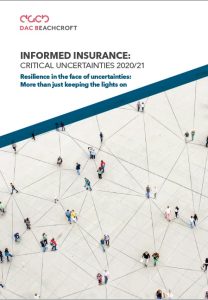
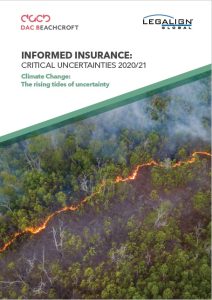
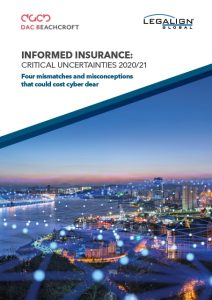
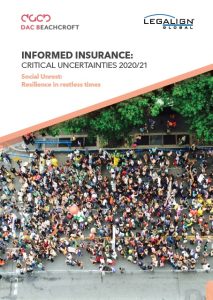
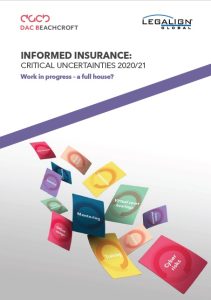
- Critical Uncertainties – Resilience in the face of uncertainties: more than just keeping the lights on. Download PDF
- Climate Change – The rising tides of uncertainty (Kristine Vale, W+K). Download PDF
- Cyber – Four mismatches and misconceptions that could cost cyber dear (Kieran Doyle, W+K). Download PDF
- Social Unrest – Resilience in restless times (Kristine Vale, W+K). Download PDF
- World of Work – Work in progress: a full horse? (Chris Mossman, Rebecca Scott, Murray Grant, W+K). Download PDF
The growing dependence on technology and our hurried transition to remote working as a result of the pandemic has increased opportunities for malicious cyber-actors to target vulnerable organisations.
Wotton + Kearney’s Australian Cyber Team Kieran Doyle talks to Insurance NEWS on the impact on the insurance industry of the government’s efforts to improve Australia’s cyber-resilience and crack-down on e-crime and state sponsored cyber-attacks.
You can download the full article below.
There have been a number of general liability trends strengthening or emerging across 2020.
Construction risks remain a hot topic given the increased infrastructure activity across all states, coupled with the high levels of political, public and media attention on building defects and cladding issues. There is also growing interest in litigation funding activity focussing on nuisance-based economic loss claims. Another sector reported to have a strong pipeline of planned activity is mining. This will shine a light on an increase in mine site injury claims and ‘worker to worker’ claims across the industry.
Following the Royal Commissions, we continue to see high levels of historical sexual abuse claims and expect to see a rise in abuse and neglect claims in the aged care and disability sectors. In the mental health injury claim space, the circumstances in which claims are being brought are expanding. This is causing a rise in claim levels and, at times, creating complex policy indemnity issues. Concern is also growing around a number of significant risks seen globally, including latent injury risks, concussion in sport, climate change and COVID-19.
You can view the full update here. Also below we will be adding a series of short video overviews from our senior specialists on each of the trends. If you would like to discuss any of the topics covered in this update, please contact me or one of W+K’s general liability partners.

Charles Simon
Partner & General Liability Practice Leader
T: +61 2 8273 9911
[email protected]
A year after the Royal Commission report was submitted, claims handling has emerged in its wake as one of the biggest issues for the insurance industry.
The Financial Sector Reform (Hayne Royal Commission Response) Act 2020 (the Act) was given assent on 17 December 2020. Schedule 4 of the Act which has the effect of making handling and settling a claim a financial service under the Corporations Act 2001 (Corporations Act) will commence on 1 January 2021. As a consequence, insurers will face higher compliance costs and a more assertive regulator in 2021.
In this article, W+K’s Charu Stevenson and Cain Jackson look at the issues for the insurance industry in 2021 and beyond.
Click on the download to read the full article.
Wotton + Kearney is pleased to provide our 2021 Insurance Predictions Report, looking at the major trends and issues we expect will remain in the spotlight for the insurance industry in our region this year.
It’s no surprise that this report addresses some of the horizon issues that we expect to face in the wake of COVID-19, ranging from pandemic-related mould and legionella risks to class action exposures.
We look at the way many longer-standing issues continue to evolve, including corporate governance exposures, litigation funding, the impact of climate risks, the rising stakes around cyber security, and increasing levels of regulatory pressure.
We also consider emerging issues, such as the real likelihood of a local sports injury class action, the constantly expanding circumstances behind mental health injury claims and the complex coverage questions raised given the potential application of multiple policy periods.
This publication features predictions made by senior lawyers from Wotton + Kearney’s Australian and New Zealand offices, which have been grouped and categorised by major product lines for your convenience.
You can also view more than 140 global predictions on the Informed Insurance microsite hosted by our Legalign Global colleagues, DAC Beachcroft, with contributions from all five Legalign Global alliance firms.
I hope you enjoy reading our latest predictions report. Our team of insurance specialists are available to discuss any of these issues with you.

David Kearney
Chief Executive Partner
Welcome to Wotton + Kearney’s NZ Insurance Market Trends Update, our biannual snapshot of legal trends and developments impacting claims managers, underwriters, brokers and corporates operating in the New Zealand market.
In this edition, we look at the impact of recent matters in the areas of D&O claims, representative actions and EPL. We provide updates on longer-standing issues, such as exclusions in construction defect claims, and increased levels of regulatory pressure adding to professional indemnity risks.
We also look at some emerging trends, such as the employment claims falling out of the pandemic, the need to navigate the new Privacy Act and mandatory reporting requirements for cyber incidents, and new regulatory pressures on the medico-legal sector.
If you have any queries about any of these emerging issues or would like to know more, please get in touch with our authors or key contacts. You can read the full update at the link below or directly download a PDF here.

Antony Holden
Managing Partner – New Zealand
A recent case note from the Office of the Privacy Commissioner highlights how failures to keep personal information up-to-date, and to act on requests to update information, can lead to privacy exposures.
In this short article, Wotton + Kearney’s Mark Anderson, Joseph Fitzgerald and Johnson Zhuang look at the issues raised and ways to manage similar risks.
Click on the download below to read the full update.
Informed Insurance
The home of fresh thinking about key insurance topics by subject matter experts from around the world.
Thought leadership
We curate our thought leadership around the insurance topics that matter most.
Predictions
We anticipate issues and opportunities for clients and share our future-focused insights in this annual report.
Themes
Our themes highlight key issues for the insurance sector, from class actions to technology.










